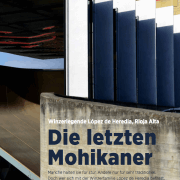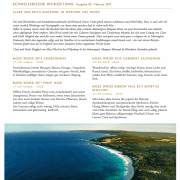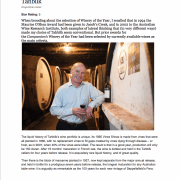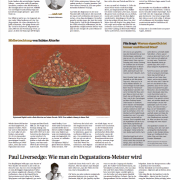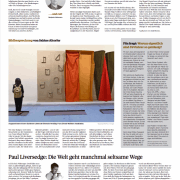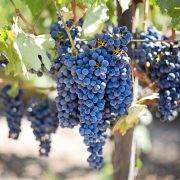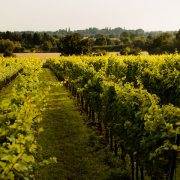Swiss wines on a new level
/0 Comments/in Master's Blog /by realwinesI love to travel and discover exciting new wines from all over the world. Yet sometimes there are wonderful surprises to be found right under one’s very nose, without having to roam too far; this was my conclusion after attending the “Swiss Wine Tasting” in Zürich last week, where over 130 of Switzerland’s best producers were presenting their wines to the press and public.
Based on this tasting, the general quality of Swiss wines has never been higher. The combination of the deliciously fresh, fruity and intense 2016 white wines and ripe-fruited, structured, fuller bodied 2015 red wines delivered many memorable tasting experiences. What surprised – and delighted me – most were that several of my favourite wines were priced under CHF25/bottle. Switzerland has an image to the outsider as being expensive, but her wines are seriously starting to offer some good value!
I particularly appreciated the diversity of flavours that Swiss whites offer, and no Swiss grape offers more individual personality than the fresh, pure, peach and apricot-fruited Petite Arvine. Without exception I would happily drink this grape from 2016 from any of the producers in the Valais whose wines I tasted. Particularly outstanding examples came from Gerald Besse, Simon Maye and Anne-Catherine & Denis Mercier. Similar to Petite Arvine in flavour, but a little fuller and rounder in body, is Amigne de Vetroz. This is a truly Swiss grape varietal; of only 40 hectares planted in the world, 10 belong to Domaine Jean-René Germanier, whose 2016 is packed full of fruit and purity. Paien (aka Heida), which is planted at higher altitudes than other Swiss white grapes, delivers excellent freshness, clarity and intensity of flavour in 2016, and at very fair prices – St Jodern Kellerei’s Heida Visperterminen 2016 at around CHF20 is a fine example. Add to this the many crisp and mineral Chasselas from the lakeside slopes of Vaud (I particularly enjoyed Luc Massy’s Clos Du Boux Grand Cru from Lavaux at CHF18/bt) and an impressive selection of fresh and floral Pinot Blancs and nutty Pinot Gris from all over Switzerland, and one really does begin to appreciate just how varied and unique Switzerland’s white wines are.
As for the reds, there were several Syrahs and Cornalins which I enjoyed from the Valais (Simon Maye’s “basic” Syrah 2016 from 30 year old vines is superb at CHF24/bt), but THE revelation of this tasting were the great value Pinot Noirs of Neuchatel. The Drei Seen region around Neuchatel has limestone soils very similar to those of Burgundy, and in distance it really is not that far away from the hallowed home of Pinot Noir. I was stunned by the silky-smooth, densely fruited Pinot Noir Tradition 2016 of Caves du Chateau d’Auvernier – my best value red of the day at only CHF17/bt – whilst Domaine de La Maison Carrée’s Pinot Noir d’Hauterive 2015 at CHF22 was my top pick of all the Pinot Noirs I tasted. This domaine is farmed biodynamically and you can taste this in its extra level of minerality, precision and vibrancy.
You may realise from the above that my attentions at this tasting were focused rather more on Suisse Romande than Deutsche Schweiz, but I did discover one fabulous producer in Aargau who was previously unknown to me – Baumgartner Weinbau. His Pinots (Blanc, Gris and Noir) were all delicious at very affordable prices between CHF15-20.
Published on 10.09.17 – Schweiz am Sonntag
WINE TIPS
Luc Massy Epesses Clos du Boux Grand Cru, Vaud 2016 at CHF 22.00/75cl
La Maison Carrée, Pinot Noir d’Auvernier, Neuchatel 2015 at CHF 27.00/75cl
Fromm Malanser Pinot Gris, Graubünden 2016 at CHF27.00/75cl
[/av_textblock]
How to become a “master” taster
/0 Comments/in Master's Blog /by realwinesThe challenge of becoming a “Master” taster
This year’s Master of Wine exams have just taken place as usual in the first week of June, a time of year which for me brings back stressful memories!
In 3 days of tasting exams, prospective new Masters of Wine need to prove that they are highly accomplished wine tasters by tasting a total of 36 wines “blind”, and achieving an overall score over 70%. These exams are the culmination of many months of intense training of one’s nose and palate, just as a top athlete must train his body to achieve perfect performance in an Olympic games, or a trainee lawyer or accountant must hone his mental powers on the build up to his professional exams. Always at the back of one’s mind is the knowledge that only a very small percentage of students actually pass the tasting exams each year.
Contrary to what people may think, the MW student does not need to identify precisely each wine tasted. For wines from the world’s classic regions (Bordeaux, Burgundy, Rioja, Tuscany etc) they need to assess correctly the wine’s region of origin (eg Pauillac, Bordeaux), vintage and level of quality within that region (eg a 2ème Cru Classé retailing at around CHF120/bt.) But they are not expected to recognise that the wine is Chateau Ducru Beaucaillou, for example. For wines from all other wine producing regions, the key is to describe correctly each wine’s attributes, style, quality and ageing potential and then reach a logical and accurate conclusion as to its origin, grape varieties and approximate price.
So what are the benefits of learning to be a “Master taster”?
Most wine drinkers imagine it is to be able to identify any wine blind, so you can wow your friends/guests/customers forever more with your amazing tasting powers! But in reality, nobody can do this infallibly, however gifted they may be, and anyway, on its own this is not a skill which really adds that much value to the role of a wine merchant or wine sommelier when dealing with their customers.
The real benefit of the MW wine tasting training is that it gives you a rock-solid understanding of how to assess and judge a wine’s quality and value. In the end, it is the search for really good quality – at varying price points – which is the overriding goal of most wine lovers. The following are the key attributes one should consider when judging a wine’s quality:
1) The length of the finish or aftertaste once the wine is no longer in your mouth – the longer the better!
2) Its complexity – the number of different flavours and sensations a wine gives you is directly related to its complexity, and again, the more the better. For example a Grand Cru Burgundy should have significantly more complexity than a simple Bourgogne Rouge from the same producer.
3) The balance between the key components of the wine – its fruit and oak flavours, acidity, tannin and alcohol levels. No one component should stand out too obtrusively, and the more you have of each, the longer the potential life of that wine.
4) Its intensity and concentration of flavour – generally the higher the better.
5) Its sense of place and “minerality” – important in assessing the classic wines of the world, in particular Burgundy and the Mosel. Pinot Noir, Chardonnay and Riesling are the grapes which are capable of expressing their unique terroirs more vividly than any others.
Why not try the following 3 wines for yourself, which come from this year’s MW white wine tasting exam, and see if the above guidance helps you assess their quality!
WINE TIPS
Trimbach Muscat Réserve, Alsace, France 2014 CHF 17.50/75cl from www.cavedereve.ch
Pazo de Villarei Albarino, Rias Baixas, Spain 2014 CHF 18.00/75cl from www.vogelsangerweine.ch
Georges Vernay Condrieu, Coteau de Vernon, Rhône, France 2014 CHF 95.00/75cl from www.de.millesima.ch
Great rivers and their great wines
/0 Comments/in Master's Blog /by realwinesHave you ever wondered why so many of Europe’s best known wine regions are situated next to major rivers?
The great chateaux of the Médoc along the River Gironde in Bordeaux; the famous hills of Hermitage and Cote Rotie on the Rhone south of Lyon; Sancerre, Vouvray, Muscadet et al along the Loire; the best producers of Rioja on the Ebro; Ribera del Duero and Portugal’s Douro Valley wine region along the Douro; Germany’s Rheingau and Mosel regions; Wachau and Kremstal on the Danube in Austria; the list goes on and on…
Of course, historically, rivers were an essential means of transport between wine producers’ cellars and their end customer markets. Overland transport of wine by container truck was not an option in the 19th and early 20th centuries – neither the vehicles nor the roads to carry them existed! The wine logistics process relied almost entirely on shipment by river and sea, hence the necessity for wine producers of being near a big river, and the importance of wine-shipping ports such as Bordeaux and Porto.
But rivers also have a significant impact on the quality and style of the grapes which are grown along them.
The microclimate near a river is special. Rivers moderate temperature, making very hot regions such as Portugal’s Douro Valley slightly cooler, or cooler regions such as the Mosel Valley in Northern Germany slightly warmer. They help protect against extremes of temperature, which can be life-saving for the grapes in times of intense cold or heat. In years when frost affects the vines late in the Spring, once the grape’s buds have formed on the vines, such as 1991in Bordeaux or more recently 2017 across much of Northern Europe, vineyards situated near a river can be up to 2C warmer than those which are not; this can make the difference between life and death for these young buds.
Rivers reflect sunlight onto the vineyards along their banks, which is again beneficial in a “marginal “ climate or cooler vintage, where grapes need the maximum possible sunlight and warmth in order to ripen fully. The vineyards along the Rhein in Kanton Schaffhausen or further north in Germany’s Rheingau for example benefit from this. The steepness of the hill-slopes one often finds along river banks also helps optimise the vines’ exposure to the sun’s rays .
Last but not least, rivers develop over many thousands of years and thus have their own unique geology and soils. Rivers generally have stony beds and the soils along their banks are equally so. Stony soils are important because they provide good drainage to vines; very few grapes benefit from having their roots immersed constantly in water. And different stones do seem to give slightly different styles of “minerality” to the vines; the slatey soils along the banks of the Mosel give a uniquely fine and intense acidity to Riesling grapes, the granitic soils of Northern Rhone give an iron fist and masculinity to the Syrah grapes of Hermitage and so on.
So it is in fact no coincidence that Europe’s greatest rivers are peppered with wonderful vineyards up and down their banks!
Published on 15.07.2017 – Schweiz am Sonntag
Grenache – the under-appreciated over-achiever
/0 Comments/in Master's Blog /by realwinesAsk most red wine drinkers for their favourite red wine grape variety and they are likely to mention Cabernet Sauvignon, Pinot Noir or Syrah. Very few would think of Grenache, but this grape, aka Garnacha in Spain and Cannonau in Sardinia, produces some of the most outstanding red wines in the world.
The reason it remains so little known is that it is usually blended with other grapes. With its enticing, soft strawberry fruit flavours, fleshy mid palate and alcoholic richness it is the warm “heart” of many of our favourite wine styles. In France’s Southern Rhone and south west it provides the perfect foil to Carignan and Mourvedre’s more gamey flavours and rustic tannins, and Syrah’s peppery fruit and acidity and firm, long-lived tannins.
Grenache is a late-ripening grape but as long as it receives enough sun and warmth it is capable of producing high yields of fruity, powerful red wine at very reasonable prices; it is for example the main grape behind almost all of the excellent value reds from the Cotes du Rhone and Languedoc. If yields are restricted however – either by planting on very dry, stony soils, or through allowing the vines to continue producing into their old age – then Grenache can produce some of the most sexy and hedonistic wines on the planet, with wonderfully concentrated fruit flavours, spicy acidity and firm, silky tannins. Chateau Rayas, Henri Bonneau and Les Bosquets des Papes in Chateauneuf Du Pape; Domaine des Bosquets in Gigondas, and Domaine Gauby in the Cotes du Roussillon are just a few of the great producers making world class reds from ancient Grenache vines.
Garnacha is widely planted in Northern Spain. In Rioja it almost always plays a supporting role to Tempranillo, but in Priorat it shows its true potential, either on its own or blended with Carignano. On the rugged, steep, slatey slopes of the Priorat hillsides southwest of Barcelona, old Garnacha vines produce scintillatingly profound, rich, mineral reds with high alcohols over 15% and velvet-smooth tannins. Just across the Mediterranean in Sardinia, Grenache is known as Cannonau and produces deep, rich, full bodied red wines. Cantine Argiolas and Sella e Mosca make excellent value examples.
The true test of a world class grape variety is how well it can adapt to different wine regions across the world. Grenache was planted in the hot, dry Barossa and McLaren Vale regions of South Australia as early as the mid 19th century and there are still many fabulous old vine examples being produced in these areas. The Australians increasingly refer to Grenache as their “Pinot Noir of the south”, due to its complex array of red fruit aromatics, silky smooth tannins and sweet, hedonistic opulence. Yalumba, Torbreck, Kalleske and D’Arenberg produce some of the finest single varietal expressions but you will more often find it blended with Mourvedre and Shiraz to produce “GMS” – great value, warm and hearty Cotes du Rhone style reds.
In California too, Grenache makes some deliciously powerful blockbuster reds, particularly in the hands of top Rhone-style specialists such as John Alban of Alban Estate or Manfred Krankl of Sine Qua Non.
And of course, Grenache also makes most of Southern France’s best Rosés, but that’s for another time…!
Published on 26.03.2017 – Schweiz am Sonntag
WINE TIPS – 3 great old vine Grenaches!
Domaine des Bosquets, Gigondas 2015 at CHF 30.00/75cl
D’Arenberg Derelict Vineyard, Old Vine Grenache 2102 at CHF 25.00/75cl
Bosquet Des Papes A La Gloire de Mon Grand Pere, Chateauneuf Du Pape 2012 at CHF 75.00/75cl
Around the world in 80 Wines! The Real Wines big Autumn Wine Tasting
/0 Comments/in Past Events /by realwinesGusbourne Estate – the crème de la crème of English sparkling wines.
/0 Comments/in Past Events /by realwinesJoin our newsletter
Real Wines
Strada al Castell 22
6921 Vico Morcote
043 466 08 90

